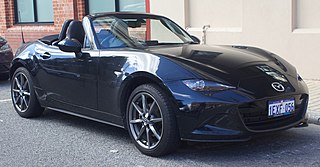
Automobiles Ettore Bugatti was a French car manufacturer of high-performance automobiles, founded in 1909 in the then-German city of Molsheim, Alsace by the Italian-born industrial designer Ettore Bugatti. The cars were known for their design beauty and for their many race victories. Famous Bugattis include the Type 35 Grand Prix cars, the Type 41 "Royale", the Type 57 "Atlantic" and the Type 55 sports car.

Karl Friedrich Benz was a German engine designer and automobile engineer. His Benz Patent Motorcar from 1885 is considered the first practical automobile. He received a patent for the motorcar on 29 January 1886.

The automotive industry is a wide range of companies and organizations involved in the design, development, manufacturing, marketing, and selling of motor vehicles. It is one of the world's largest economic sectors by revenue. The automotive industry does not include industries dedicated to the maintenance of automobiles following delivery to the end-user, such as automobile repair shops and motor fuel filling stations.

A coupé or coupe is a two-door car with a fixed roof. In the 21st century there are four-door cars with a coupé-like roofline sold as "four door coupés" or "quad coupés".
Grand Prix motor racing, a form of motorsport competition, has its roots in organised automobile racing that began in France as early as 1894. It quickly evolved from simple road races from one town to the next, to endurance tests for car and driver. Innovation and the drive of competition soon saw speeds exceeding 100 miles per hour (160 km/h), but because early races took place on open roads, accidents occurred frequently, resulting in deaths both of drivers and of spectators.
Automotive engineering, along with aerospace engineering and naval architecture, is a branch of vehicle engineering, incorporating elements of mechanical, electrical, electronic, software, and safety engineering as applied to the design, manufacture and operation of motorcycles, automobiles, and trucks and their respective engineering subsystems. It also includes modification of vehicles. Manufacturing domain deals with the creation and assembling the whole parts of automobiles is also included in it. The automotive engineering field is research -intensive and involves direct application of mathematical models and formulas. The study of automotive engineering is to design, develop, fabricate, and testing vehicles or vehicle components from the concept stage to production stage. Production, development, and manufacturing are the three major functions in this field.

A sedan — also saloon — is a passenger car in a three-box configuration with separate compartments for engine, passenger and cargo.

A roadster is an open two-seat car with emphasis on sporting appearance or character. Initially an American term for a two-seat car with no weather protection, usage has spread internationally and has evolved to include two-seat convertibles.

The BMW E46 is the fourth generation of the BMW 3 Series, which was produced from 1997 to 2006. The body styles of the range are:

A mid-size car— also known as intermediate— is a vehicle size class which originated in the United States and is used for cars that are larger than compact cars, but smaller than full-size cars. The equivalent European category is D-segment, which is also called "large family car". Mid-size cars are manufactured in a variety of body styles, including sedans, coupes, station wagons, hatchbacks and convertibles.

The Paris Motor Show is a biennial auto show in Paris. Held during October, it is one of the most important auto shows, often with many new production automobile and concept car debuts. The show presently takes place in Paris expo Porte de Versailles. The Mondial is scheduled by the Organisation Internationale des Constructeurs d'Automobiles, which considers it a major international auto show.

The early history of the automobile can be divided into a number of eras, based on the prevalent means of propulsion. Later periods were defined by trends in exterior styling, size, and utility preferences.

A car is a wheeled motor vehicle used for transportation. Most definitions of car say they run primarily on roads, seat one to eight people, have four tires, and mainly transport people rather than goods.

Fiat Automobiles S.p.A. is an Italian automobile manufacturer, a subsidiary of FCA Italy S.p.A., which is part of Fiat Chrysler Automobiles. Fiat Automobiles was formed in January 2007 when Fiat reorganized its automobile business, and traces its history back to 1899 when the first Fiat automobile, the Fiat 4 HP, was produced.

A limousine is a luxury vehicle driven by a chauffeur with a partition between the driver's compartment and the passenger's compartment.
The FIA World Endurance Championship is an auto racing world championship organized by the Automobile Club de l'Ouest (ACO) and sanctioned by the Fédération Internationale de l'Automobile (FIA). The series supersedes the ACO's former Intercontinental Le Mans Cup which began in 2010, and is the first endurance series of world championship status since the demise of the World Sportscar Championship at the end of 1992. The World Endurance Championship name was previously used by the FIA from 1981 to 1985.
American(s) may refer to:

FCA Italy S.p.A. is the Italian subsidiary of the Italian-American automaker Fiat Chrysler Automobiles, dedicated to the production and selling of passenger cars and light commercial vehicles and headquartered in Turin, Italy.















